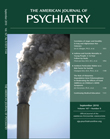T
o the E
ditor: I agree with the statement by Bryon Adinoff, M.D., and Michael Devous, Ph.D. (
1), in their Letter to the Editor published in the May 2010 issue of the
Journal, that “it is likely that, within the next decade, Dr. Amen's claims [and fervent hope] will be realized in that psychiatrists will enjoy the ability to diagnose and prescribe treatments based, in part, upon neuroimaging findings” (1, p. 598). Imaging is now being used by psychiatrists here in the United States, in Canada, and abroad to aid patients. I cannot imagine anything more damaging to the imaging field, however, than encouraging medical board investigations for those who are early adopters. The California Medical Board investigated my use of single photon emission computed tomography (SPECT) 13 years ago, found no violation, and encouraged me to publish our findings, which I have done.
One would think that a more enlightened attitude toward a field, as plagued by uncertainties as psychiatry still is, would welcome the practical application of neuroimaging. In 2001, Camargo wrote “Brain SPECT is rapidly becoming a clinical tool in many places, particularly in dementias, head injury, [obsessive compulsive disorder] OCD, Tourette's, schizophrenia, depression, panic disorder, and drug abuse” (
2). Additionally, Brockman demonstrated SPECT's usefulness in choosing between treatments for depression (
3).
Our work is based on hundreds of texts and scientific articles, including 26 articles and the chapter on functional imaging in the
Comprehensive Textbook of Psychiatry that I co-authored (
4). Respected hospitals, such as Sierra Tucson, have added SPECT to their armamentarium. Thoughtful clinicians would never use SPECT in isolation, and contrary to what was written about me, I have never recommended such use.
Clinical practice and careful observations have provided researchers with important hypotheses to test, and I have successfully invited researchers to use our database of rigorously diagnosed patients, including SPECT when indicated, to advance neuroimaging, and I extend the same invitation here.
The Society of Nuclear Medicine has never formally approached me to perform a study. Plus, I would never engage in a charade where I was expected to give a diagnosis from a scan. That is not how imaging is or should be practiced. The notion of Adinoff and Devous that SPECT is dangerous is disingenuous. Devous recently wrote, “SPECT and PET have no more risk than MRI-based procedures” (
5).
The hope that SPECT and other imaging modalities will be as routine and useful to psychiatry as imaging the heart is to cardiology has animated my practice for nearly 20 years. It, indeed, is starting to happen. My hope is that our journal will help translate imaging research into clinical practice rather than threaten practitioners who have been trying to make it happen.

